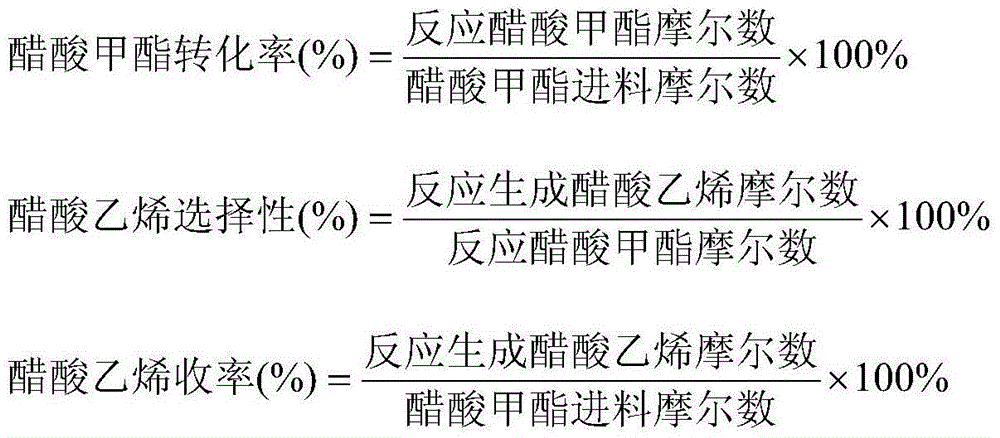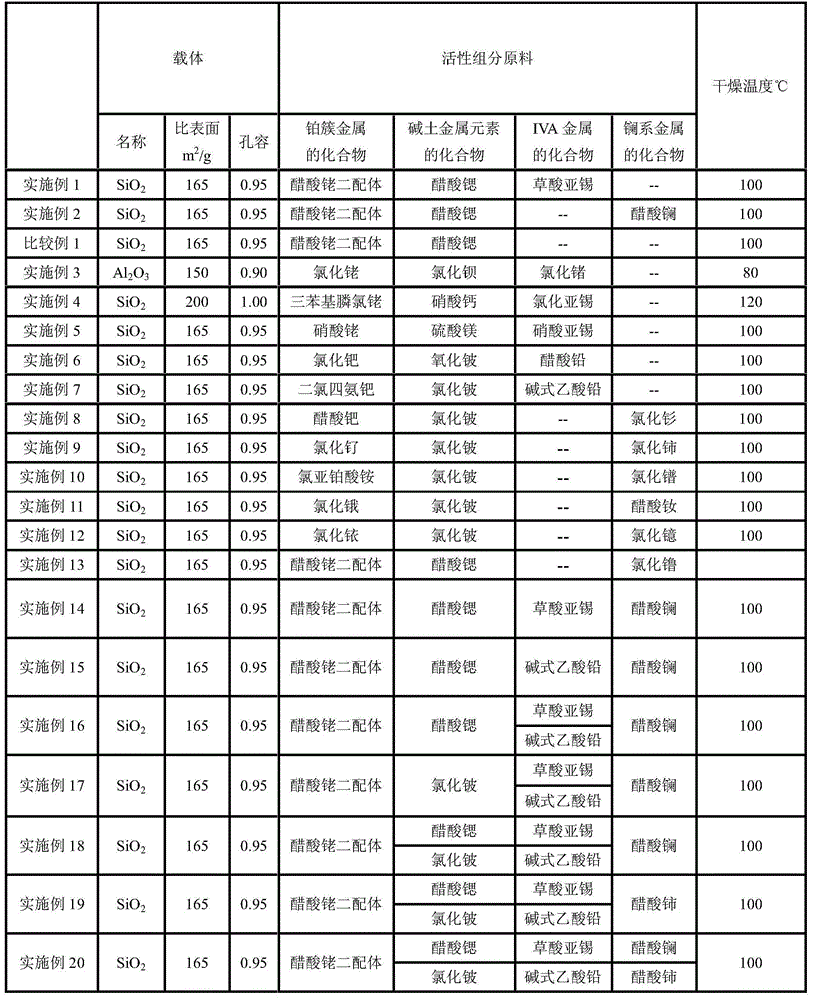Method for producing vinyl acetate through methyl acetate carbonylation
A technology of methyl acetate and vinyl acetate, applied in the field of vinyl acetate carbonylation of methyl acetate, can solve the problems of low vinyl acetate yield and low selectivity, and achieve improved activity and stability, increased yield and selectivity Effect
- Summary
- Abstract
- Description
- Claims
- Application Information
AI Technical Summary
Problems solved by technology
Method used
Image
Examples
Embodiment 1
[0026] The preparation of carbonylation catalyst: will contain 6.10gRh, contain 2.90gSr and contain the rhodium acetate two part of 2.90gSn (Rh 2 (OAc) 4 ), Sr(OAc) 2 0.5H 2 O and stannous oxalate (SnC 2 o 4 ) is fully mixed and dissolved in hydrochloric acid with a concentration of 8wt%, to obtain 400ml of impregnating solution, and the specific surface of 1.0L is 165m 2 / g, spherical SiO with a pore volume of 0.95 and a diameter of 5.6mm 2The carrier was immersed in the above impregnating solution, left to stand for 2 hours and dried at 100° C. to obtain the catalyst. The carbonylation catalyst was analyzed by ICP, and the Rh content was 6.10 g / L, the Sr content was 2.90 g / L, and the Sn content was 2.90 g / L.
[0027] Synthesis of vinyl acetate:
[0028] Step (1): Add 1.5 mol of acetic acid, 0.05 mol of carbonylation catalyst, 0.10 mol of methyl iodide and 0.45 mol of methyl acetate into a 500ml titanium reactor, first use argon to discharge the air in the reactor and ...
Embodiment 2
[0033] The preparation of carbonylation catalyst: will contain 6.10gRh, contain 2.90gSr and contain 2.90gLa rhodium acetate two ligands (Rh 2 (OAc) 4 ), Sr(OAc) 2 0.5H 2 O and La(OAc) 3 ·5H 2 O is fully mixed and dissolved in pure water to obtain 400ml of impregnation solution, and the specific surface of 1.0L is 165m 2 / g, spherical SiO with a pore volume of 0.95 and a diameter of 5.6mm 2 The carrier was immersed in the above impregnating solution, left to stand for 2 hours and dried at 100° C. to obtain the catalyst. The carbonylation catalyst was analyzed by ICP, and the Rh content was 6.10 g / L, the Sr content was 2.90 g / L, and the La content was 2.90 g / L.
[0034] Synthesis of vinyl acetate:
[0035] Step (1): Add 1.5 mol of acetic acid, 0.05 mol of carbonylation catalyst, 0.10 mol of methyl iodide and 0.45 mol of methyl acetate into a 500ml titanium reactor, first use argon to discharge the air in the reactor and pressurize to 2.0MPa, then Introduce carbon monoxid...
Embodiment 3
[0049] Preparation of carbonylation catalyst: RhCl containing 5.00gRh, 1.00gBa and 1.00gGe 3 ·6H 2 O, BaCl 2 and GeCl 4 Fully mixed and dissolved in hydrochloric acid with a concentration of 8wt%, to obtain 400ml of impregnation solution, and the specific surface of 1.0L was 150m 2 / g, spherical Al with a pore volume of 0.90 and a diameter of 5.6mm 2 o 3 The carrier was immersed in the above impregnating solution, left to stand for 2 hours and dried at 80° C. to obtain the catalyst. The carbonylation catalyst was analyzed by ICP, and the Rh content was 5.00 g / L, the Ba content was 1.00 g / L, and the Ge content was 1.00 g / L.
[0050] Synthesis of vinyl acetate:
[0051] Step (1): Add 1.5 mol of acetic acid, 0.05 mol of carbonylation catalyst, 0.10 mol of methyl iodide and 0.45 mol of methyl acetate into a 500ml titanium reactor, first use argon to discharge the air in the reactor and pressurize to 2.0MPa, then Introduce carbon monoxide and hydrogen until the pressure is 7...
PUM
| Property | Measurement | Unit |
|---|---|---|
| Specific surface | aaaaa | aaaaa |
| Diameter | aaaaa | aaaaa |
| Diameter | aaaaa | aaaaa |
Abstract
Description
Claims
Application Information
 Login to View More
Login to View More - Generate Ideas
- Intellectual Property
- Life Sciences
- Materials
- Tech Scout
- Unparalleled Data Quality
- Higher Quality Content
- 60% Fewer Hallucinations
Browse by: Latest US Patents, China's latest patents, Technical Efficacy Thesaurus, Application Domain, Technology Topic, Popular Technical Reports.
© 2025 PatSnap. All rights reserved.Legal|Privacy policy|Modern Slavery Act Transparency Statement|Sitemap|About US| Contact US: help@patsnap.com



